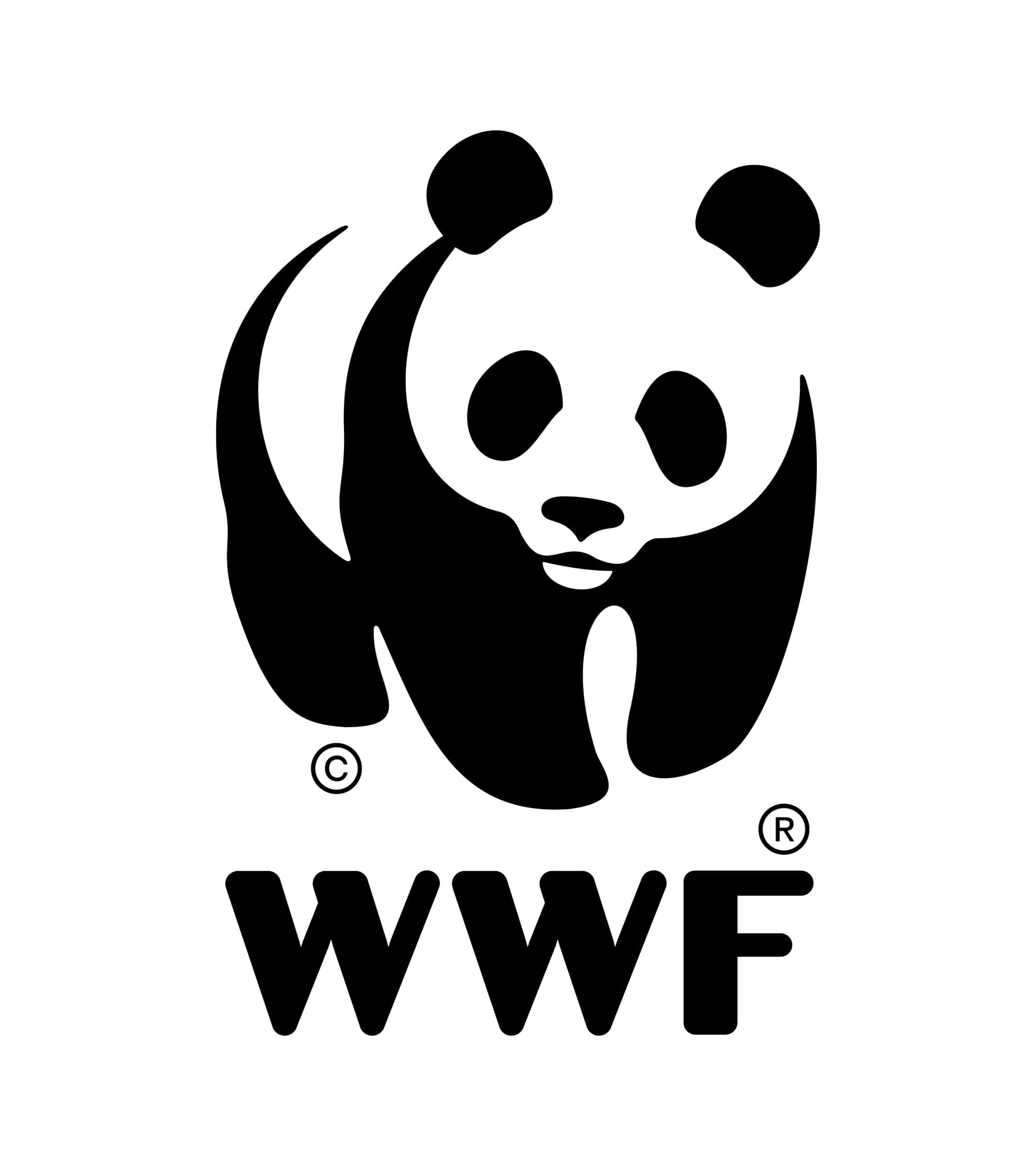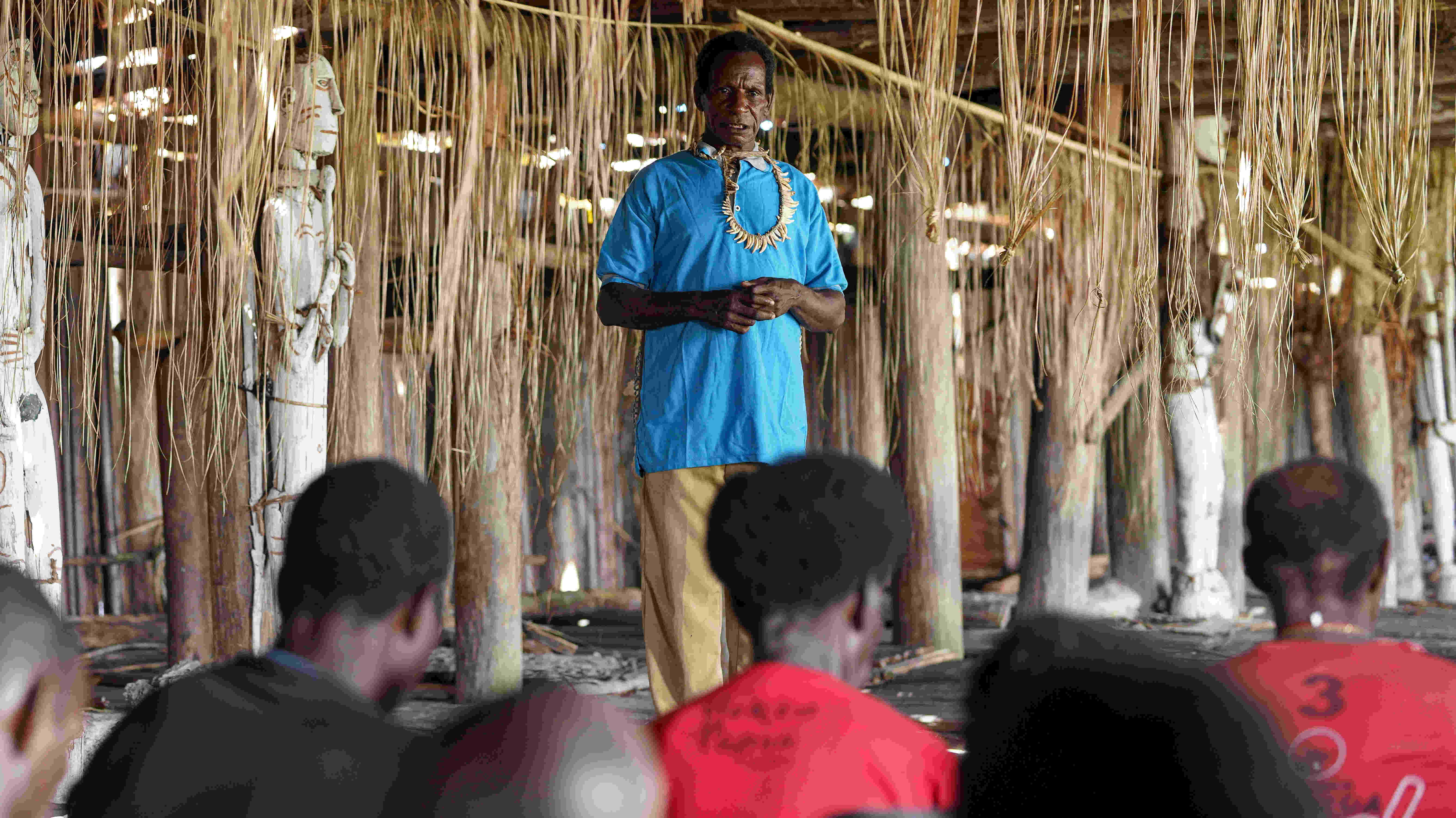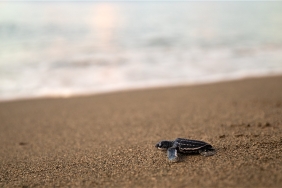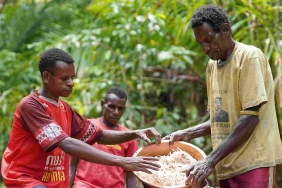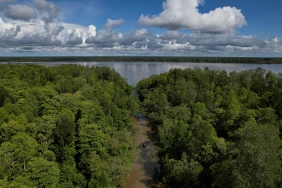PREVENTING DISASTERS FROM THE BEAUTIFUL PAPUA
He appears approachable and warm. His lips curve into a smile often, especially for new guests that he just met for the first time. This young Papuan man gives an impression of being skillful and agile. Through is self-confidence, he showcases his skills with ease.
In the beginning, he introduced himself. "Filemon," he said briefly, while extending his hand to the village guests.
Filemon, with a sturdy physique, seemed to have inherited the appearance of his father, Hendrikus Wowokti, the head of the Erma village in the Sawa Erma District, Asmat Regency, Papua.
Upon closer inspection, Filemon's face resembled the village chief's, but the young Asmat man appeared fresh and full of energy. He was bold and not shy. Filemon guided guests from more modernized cities to explore the sago forest, which stood tall above the muddy ground.
With great precision, Filemon cleared the path. Not only that, the youngest son of Hendrikus prepared a special trail for guests who had difficulty walking on the muddy forest floor. He arranged coconut leaves in a neat row to make it easier for guests to step their feet without sinking into the mud up to 80 cm deep.
Despite completing only junior high school, Filemon didn't show any signs of being insecure about his education. When explaining the sago harvesting process, Filemon spoke masterfully and fluently about the subject. It seemed like he was satisfying the thirst of knowledge that came from his guests, who had no experience in harvesting the staple food of the Erma village.
"The sago that needs to be harvested belongs to this sub-village here. We have discussions before harvesting. This is the tool we use to cut,”
Filemon explained to his newly acquainted guests. This agile young Asmat then continued to describe the sago harvesting process.
“When the sun comes out, we choose which plant to harvest. After cutting down the tree, we peel the outer bark and take the inner part. Then, we open and chop the inner part into pieces. After chopping, we ramas, ramas.”
Suddenly, the face of Hengky, one of the guests, wrinkled. "What is 'ramas’? I'm sorry," he asked in confusion.
Filemon quickly answered the first-time viewers of the Asmat sago harvesting process. “After the the sago plant is chopped. The chopped sago plant is put in 4 of these containers made to release and separate the sago from the plant itself. We take water and pour it over chopped sago in the container and then we squeeze and knead the mixture. The container strains the sago plant pulp, and the water that remains will contain the sago starch. This process takes quite a long time about 24 hours.”
Then, Filemon continued his story. "The sago starch sinks to the bottom of the water. If the process is fast, by the evening people can go home. If the process isn't finished, the sago harvesters must stay overnight among the sago trees in the muddy wilderness."
“We can also bevat here. Bevat is a temporary shelter, temporary resting place, made from leaves. After kneading. The sago starch has sunk to the bottom of the container. We can pour out the excess water and the sago starch remains.
We can reuse the sago plant pulp again for the same process three to four times. Depending on the plant, make sure we utilize the plant at least three times in order not to be wasteful,” explained the village chief's son warmly.
"Oh, I see, the water only comes from here?" asked one of the guests of Erma village, who was enthusiastic about seeing the sago harvesting process with their own eyes.
"Yes, the water comes from here," pointing to the muddy ground with a pool of water.
"Is it adequate?"
Filemon continued patiently to answer their incessant questions that never stops, like waves of the open sea.
"It's enough. The forest water’s quality is good, clean, delicious. Water that is suitable for consumption. Here, the water is still clear, but in the deep forest, the water turns red. When chopped sago plant pulp is available, we work right away through the kneading and straining process. After being used three times, we throw away the pulp, and use new sago plant pulp. When water is mixed with the pulp it turns white like the color of milk.”
According to this young man born in the Erma village, the white milk-like water can also quench one's thirst.
"Chopping sago plant doesn’t take too long, less than 24 hours. After one hour of chopping we can start kneading and straining. When there is many of the chopped sago plant available, we can continue the process. Depending on our energy if it's a pair of husband and wife. The wife helps and the husband helps energetically, the process becomes fast when you work together. It’s like teamwork, helping each other, right?”
Teamwork, a spirit that is currently rarely heard from the lips of Indonesians, is vividly observed in the implementation of the Voices for just Climate Action (VCA) program in Asmat, one of the beautiful corners of Papua.
Village figures, indigenous community organizations, and the church are working hand in hand in mapping the area, a joint effort in the VCA program under the supervision of WWF-Indonesia.
The church has made tireless efforts, conducting socialization through its council. The pastor also encouraged the residents to participate in this program. Thus, the Erma village neighbors gladly joined the activities that could help prevent future disasters.
Kampung Sono is adjacent to Filemon's hometown. These two villages are connected by a wooden bridge. They live in harmony. Sono is adorned with a beautiful natural panorama. The beauty of this corner of Papua is vividly portrayed and satisfies the curiosity of guests who have traveled far of around 3,400 kilometers.
The beautiful view is clearly visible from Sono and Erma's churches. Guests only need to walk a few meters forward through the wooden pathways in the village. The journey to that area is accompanied by trees and some speedboats. Of course, the water area is not far from Sono village's mini dock.
In that place, newcomers can see the clear waters and dense trees across from Sono village. Sometimes, the speedboats passing by add to the beauty of the scenery. Not only that, collectively, flying birds looking for food also grace the beautiful landscape of Sono village.
One interesting uniqueness of this village is its church. Although under the Catholic diocese, the village church still looks down-to-earth, blending with the various buildings scattered throughout the Asmat village. The tangible sign is the "Gereja Bunda Maria Erma-Sono" (Church of Mother Mary Erma-Sono) with its simple design, resembling a combination of a mailbox and a house.
The church building is also relatively long with a triangular roof made of metal, similar to typical houses. Next to the church is a large rectory. Like in Sawa-Er, the rectory is spacious enough to have a central area, a dining area, and more than one bedroom, all made of wood.
Herman Ear, the head of Sono village, obeys the church's rules. Herman believes that being part of the church community is not just about worship and service but also about work. He has learned that the church also encourages people to connect with nature.
The most important foundation for preserving nature, according to the church, is recognizing that faith is a working spirit. Nature has a spirit, and so do humans. However, humans have damaged and even destroyed nature. He continues, "Humans and nature, it's one of the spirits that we can unite, and it becomes our united brotherhood. That's why I've only learned and joined it. It's better for me to consider it. Consider that nature is one, our friend from the Almighty. Only to avoid what others have done, but let's try not to harm, our nature, so we need to set boundaries."
As someone who has served as the village chief for 23 years, Mr. Herman is involved in participatory mapping. According to him, WWF-Indonesia's discourse was introduced in the 1990s. Only in the 2000s did participatory mapping take place.
The man who enjoys wearing traditional Asmat necklaces believes that the main issue before mapping was disputes between sub0viollages due to unclear boundaries. In pursuing mapping, the approach was similar: planting coconut trees, breadfruit trees, bamboo, and guava to establish boundaries. However, Herman added that every boundary plant that fell required his community to replant it, ensuring that the demarcation lines remained clear. This specific planting was located on the outskirts of the bevat, where they rest while processing sago or looking for food.
Herman hopes that WWF-Indonesia can continue its program, understanding that the younger generation tends to be money-oriented. In the past, they were only connected to the environment that provided their food and drink, bringing them back to their families.
According to Herman, money has no family, nor does it have siblings. Unfortunately, money also destroys all the trees. After they turned into money, the wealth is not shared with his family or relatives. Herman shared his thoughts on his concerns about the future. That is why he insists on protecting their forest. Mapping the territory may contribute to alleviating his concerns about the future.
In a separate opportunity, Zaani Inaury, who leads the VCA program from WWF-Indonesia, explained the comprehensive picture of the activities carried out by the Asmat residents. The spirit of cooperation to prevent disasters in this beautiful corner of Papua emerged because they joined forces with a local civil society organization (CSO), the Alfonso Suada Asmat Foundation (YASA).
"So, our partner in Asmat, which is YASA, is actually an organization under the church's purview. In this case, the approach used by WWF and its partners is a church-based approach. That means, how the community can agree and participate in the mapping process through the church, because in Asmat, the church plays a significant role. Besides the government, the community highly values and respects the Church's authority. The Church is used to facilitate one of the VCA activities, which is this mapping," Zaani explained.
According to Zaani, the goal of all working areas always refers to three pillars. One of them is how to strengthen the capacity of indigenous communities. "Because they are currently the 'victims' or those most affected by the climate crisis. On the other hand, they are the ones who effectively and efficiently preserve the environment, their customary regulations, and their traditional territories. In simple terms, they are the ones who are the most responsible for protecting, but they become the most affected victims of climate change."
In the VCA activities, Zaani stated that there are also activities related to short-term planting. So, the main program is about sago cultivation, but because their sago groves are quite far away. It takes about 40 minutes to reach their sago hamlets, which is far in terms of accessibility. The VCA program aims to move the sago to the residential area. Thus, they allocate some community land for sago cultivation. The mentioned planting is to protect the sago plants that are being cultivated.
In addition to these border plants, they also cultivate hydroponic plants. Geographically, topographically, we know that Asmat is a swampy area with no land. So, they developed hydroponic plant cultivation using artificial methods. That is, when plants are cultivated above the ground.
"So, these beds are made, and the plants are planted on them. It's actually one of the local solutions. That means the availability of land is very scarce, and the geographic conditions are swampy. So, they came up with that solution. Furthermore, for Asmat itself, in terms of regulations, the Decree of Recognition of the Pomar Sirau Indigenous Territory has been issued since October 2022. That is actually the result of a long journey since 2021. How to protect the area and the Adat Asmat Law, especially Pomar Sirau," Zaani explained.
Zaani also received some interesting questions. "Regarding the sago plants earlier, do they currently have any impact on climate change? Or what is the relationship between sago forests as one of the staple foods for the community, related to the climate change that is happening?"
With agility, Zaani explained these two deep questions. In other words, one of the points they wanted to convey, in line with the three pillars I mentioned earlier, is how local food is preserved in anticipation of the impacts of climate change. Then, functionally, sago is very beneficial for water availability and soil retention. Also, Asmat is currently experiencing rising sea levels. So, sago actually functions to protect the land from erosion, in addition to its main purpose of preserving local food.
"There is a tendency in the community to be highly dependent on rice crop. However, in the current situation, it's difficult to obtain rice. So, how can we restore the staple food (sago) not as an alternative but so that we don't depend on rice to protect against hunger or the danger of famine that occurred in 2018/2017."
Zaani also emphasized the goal of the participatory mapping activity. "Actually, one of the main activities for Asmat in this VCA program is the mapping of the customary territory in the Pomar Sirau clan. This is a participatory mapping that involves the community from the beginning. So, starting from 2021, from the pre-condition, then the community in the Pomar Sirau clan, which is about ten villages, they created a map together in a participatory manner, used as an advocacy tool to obtain the Regent's Decree."
